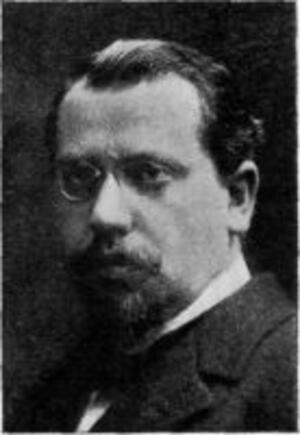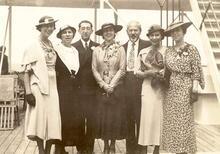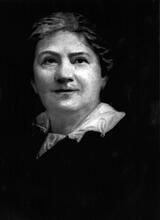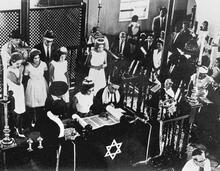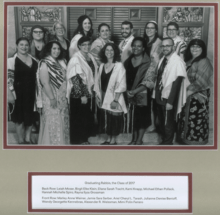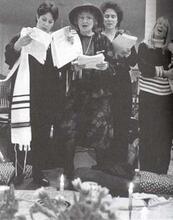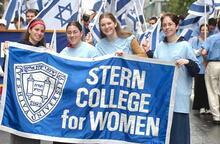Mordecai Kaplan
Mordecai Kaplan in 1915.
Courtesy of the Menorah Journal/Project Gutenburg.
Mordecai Kaplan, the founder of Reconstructionist Judaism, was a lifelong supporter of the rights of women. Early in his career, he was an ardent supporter of the emancipation of women and criticized diasporic Judaism for doing little to support this social movement. If Judaism in general offered no help on the issue of emancipation, Kaplan suggested looking to the Bible for guidance, by pointing out that the Bible includes many strong holy women. A major innovation Kaplan implemented was the Bat Mitzvah, which he organized for his daughter, Judith. Because of Kaplan, the Reconstructionist movement in the United States and Israel has been at the forefront of the struggle for women's equality.
Mordecai Kaplan (1881–1983), the founding father of Reconstructionist Judaism, was a lifelong supporter of the rights of women. The roots of his concern for women may go back to his father: Rabbi Israel Kaplan, though strictly traditional, was concerned that his daughter Sophie (a few years older than Mordecai) have a Jewish education. Although education for women was not unknown in the traditional world of East European Jewry, the clarity and devotion of Israel Kaplan to the education of his daughter was unusual. Sophie Kaplan grew up to be an educated woman who knew and taught Hebrew throughout her life. She married Nathan Israeli, a Conservative rabbinic colleague of Kaplan’s, and was active in the many congregations where he served. She may also have played a significant part in teaching her younger brother Hebrew.
Early Career
In his younger years as an Orthodox rabbi, Kaplan was a strong supporter of the rights of women. The Jewish Center, where Kaplan was rabbi from its founding in 1918 until 1922, was traditional and was reasonably progressive so far as women were concerned. Statements in the Center Journal strongly supported women’s rights but presented them in a somewhat defensive manner. For example, the following: “We are the last to subscribe to the German idea of ‘Küche, Kinder und Kirche.’ Women must play a significant role in the great social changes that are taking place.” Wherever possible women were included in important ceremonies. As part of the dedication of the Center, in 1918, a Torah she-bi-khetav: Lit. "the written Torah." The Bible; the Pentateuch; Tanakh (the Pentateuch, Prophets and Hagiographia)Torah scroll was completed by each person writing in a letter. The Center Journal noted proudly that “all the women as well as the men participated in the ceremony” (Center Journal).
At the Center, seating was separate though equal, with women sitting on both sides of a center section that was reserved for men. The sections were separated by a curtain. Because of the Center’s traditional membership there was never any question of altering the synagogue ritual to include women. The major question of the day was women’s right to vote; Kaplan advocated the emancipation of women. In his preaching he went beyond mere support of the vote, which he took for granted, but did not argue for changing any rituals to include women. In the fall of 1918, he took the occasion of the sidrah (Torah portion) of Hayyei Sarah to deal with the issue of women’s rights. Preparing the way for the sermon, The Center Journal published the following question during that week: “Shall the Emancipation of women be merely a duplication of men?” On SabbathShabbat morning Kaplan pulled no punches when he said that, “Judaism of the Galut (Lit. (Greek) "dispersion." The Jewish community, and its areas of residence, outside Erez Israel.Diaspora) has said nothing and done nothing to lay claim to any share in the Emancipation of women.” The major religions, moreover, always lagged behind when it came to movements for social betterment. He asserted that, “the movement to emancipate women was nothing more than the logical extension of democracy.”
Looking to the Bible
If Judaism in general offered no help on the issue of emancipation, Kaplan suggested looking to the Bible for guidance. He pointed out that there are many strong holy women in the Bible, including Deborah, Miriam, and of course Rebecca, who was the focus of the week’s portion. If Genesis presented us with the matriarchs, however, it also presented us with the curses of Eden. The curse on Eve reads, “Toward your husband shall be your lust, yet he will rule over you” (Genesis 3:16). It is clear, Kaplan maintained, that women are destined to be redeemed from this curse in the time to come, just as man will be redeemed from his curse. We know this because Genesis also tells us that God said, “Let us make humankind, in our image, according to our likeness! Let them have dominion over the fish of the sea …” The key word here is ve-yirdu—they, both male and female, shall rule the earth together. The ideal is that men and women were meant to be equal and the world is a fall from that ideal.
Kaplan looked closely at Rebecca and used her as a model. Women must be emancipated not for power but for service. Man’s essential sinfulness stems from his lust for power; the same is true for women. Women in the past have sought to gain power through their charms. Women have both gained and lost because of this—in Kaplan’s words, “What if not her desires to entrance man with her charms has caused man to look upon her as his doll and play thing to minister to his wants?” Thus the enslavement of woman has resulted from her femininity, “The power of the eternally feminine,” as he called it. Now women must be emancipated, not essentially for more power, but for greater service. Just as Rebecca went the extra measure in her service to Abraham’s servant so must women do the same. It is almost as if Kaplan were talking about women in the same terms that Jews in general have always talked about themselves—as the chosen people. The Jews alone are the only ones who have known God, says the prophet, and therefore they have a higher standard to follow. If women were really free, they would revolutionize the political sphere by lifting it to a higher level. The chosenness of women, he believed, made them more humane. “Women will purify politics, make industry more humane and make justice to the consumer instead of profits to the producer the standard of the market.” Emancipation is not aimed at power “… neither her own particular power, nor that masculine power which has contributed so much to the destruction of the world.” As Hannah so eloquently put it in her hymn of thanksgiving to God, “… for not by strength (power) shall man prevail.”
Kaplan was often at his best when he attempted to reinterpret fundamental concepts. At one point he put forth the idea that reverence for the individual was more basic than the concept of “love thy neighbor.” Being created in God’s image was the Biblical way of talking about the absolute value of human life: “… the reason it is wrong to take human life is that the human being wears the image of God; therefore, when a human being is slain, something more than that which is merely human is destroyed, the very image of God is shattered.” The proper attitude toward our fellow human beings is respect, the same awe and respect “… we associate with the idea of God.” We revere human life because “… it is a spark of that life that animates the universe,” Kaplan told his congregation. He believed that acting out of reverence was a higher principle than acting out of love. “It is only after mankind will have acquired the principle of reverence for man that it will be possible to love man as he should be loved, not merely ‘as thyself’ but as the reflection of the Divine. ‘Beloved is man,’ said R. Akiva, ‘for he was made in the image of God.’”
Bat Mitzvah of Judith Kaplan Eisenstein
The most interesting innovation concerning women at Kaplan’s next congregation, The Society for the Advancement of Judaism (SAJ), established in 1922, occurred a month or so after it was opened, with the Lit. "daughter of the commandment." A girl who has reached legal-religious maturity and is now obligated to fulfill the commandmentsbat mitzvah of his daughter Judith Kaplan Eisenstein. In his later life Kaplan was fond of saying that he had four reasons for instituting the bat mitzvah ceremony—namely, his four daughters, Judith, Hadassah, Naomi, and Selma. The idea for such a ceremony must have been germinating in Kaplan’s mind for quite a long time. At a United Synagogue Convention of the Conservative Movement in 1918 he raised the issue of the equality for women in the synagogue, but he made no concrete suggestions and so the discussion never developed. As Judith’s twelfth birthday came and went, Kaplan began to think about doing something appropriate for the occasion. Her bat mitzvah was celebrated on the 18th day of Adar 5682, which corresponds to March 18, 1922, when she was twelve and a half years old. A simple announcement in the SAJ Bulletin invited everyone in the congregation to a meal afterwards. There is no record of any opposition within the congregation, but Kaplan did have his difficulties. Before the event there was considerable resistance from both his mother and his mother-in-law. Judith many years later recalled the following conversation between them. “‘In-law,’” said my mother’s mother, ‘Talk to your son. Tell him not to do this thing.’ ‘Machateineste (in-law)’, said Grandma Kaplan, ‘You know a son doesn’t listen to his mother. You talk to your daughter. Tell her to tell him not to do this thing!’” The grandmothers did not prevail and the events proceeded as planned. As Judith recalls, her father did not decide what exactly she was to do until the night before. “Everything was in readiness except the procedure itself. On Friday night after Shabbat dinner, Father took me into his study and had me read aloud the blessings which precede and succeed the Torah readings. How severely he corrected my diction … He then selected a passage from the weekly (Torah) portion … which I practiced reading in both Hebrew and English.”
The services took place on the first floor of the SAJ House, as they called George M. Cohan’s converted brownstone at 41 West 86th Street, where the SAJ met, with the men seated in the front and the women seated behind. Judith had to sit up front with the men “away from the cozy protection of mother and sisters.” Strictly speaking, Judith’s bat mitzvah was not what it would have been if she were a male. Judith was called forward to recite the Torah blessings and read a portion from the weekly sidrah (Bible portion). Kaplan himself read the blessings for the portion from the Prophets and the Haftarah (Prophetic selection).
Although the ceremony was not fully equal to its male counterpart, the bat mitzvah was born and, as Judith put it, “no thunder sounded, no lightning struck … and the rest of the day was all rejoicing.” This first small step did not mean full equality for women even at the SAJ. It took more than twenty years for women to be regularly called to the Torah. The SAJ thus stood in the anomalous situation of having many bat mitzvahs but no girls who were ever again called up to the Torah. In the matter of calling women to the Torah, Kaplan chose to follow his flock, rather than to act on his conscience. This situation may have been due either to his inertia or to a lack of political savvy; it is difficult to know which.
Continued Support for Equality of Women
Kaplan continued to support the equality of women throughout his life. In his later major work, The Future of the American Jew, Kaplan devoted an entire section to the equality of women. Kaplan maintained that Jewish women were treated better than many other women in antiquity and in the pre-modern period. Yet, having said that, he also maintained that “traditional Jewish law undoubtedly treated women as a lower type of human being than man. In Jewish law, the women is on the same plane with minors, slaves and people of unsound mind.” Jewish law must therefore be amended so that women are treated equally in all aspects of Jewish life, both in theory and in practice.
We should not be surprised therefore that the Reconstructionist movement both in the United States and in Israel has been in the forefront of the struggle for the equality of women. However, we should also note that Kaplan never thought to carry his fight for the equality of women into the synagogue service itself. While quite radical in his willingness to change the traditional siddur (book of daily prayers), he never thought to make the siddur gender-neutral.
“Dedication Ceremonies and Sefer Torah.” Center Journal (May 10, 1918).
“Küche, Kinder und Kirche …” Center Journal (November 8, 1918).
Kaplan, Mordecai. “The Status of Women in Jewish Law.” In The Future of the American Jew, 405. New York: 1948.
Idem. Communings of the Spirit: The Journals of Mordecai M. Kaplan, edited by Mel Scult. Detroit: 2001.
Scult, Mel. Judaism Faces the Twentieth Century: A Biography of Mordecai M. Kaplan. Detroit: 1993 (Hebrew translation published in Tel Aviv: 2004).

